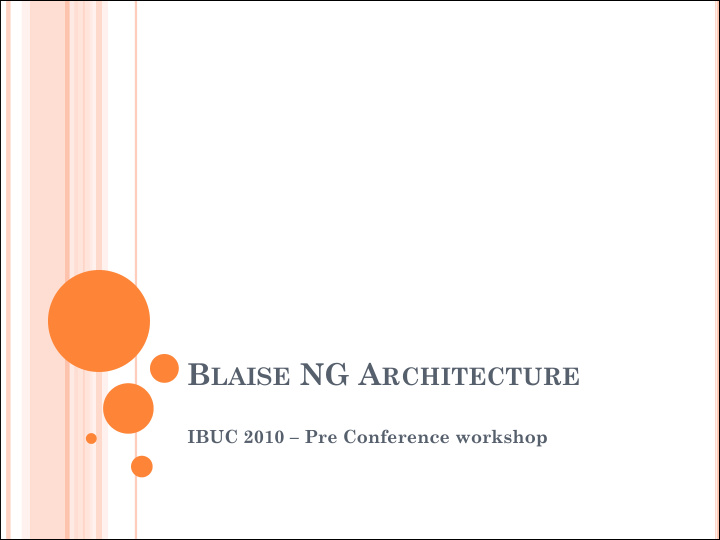



B LAISE NG A RCHITECTURE IBUC 2010 – Pre Conference workshop
I NTRODUCTION Why a new version? Design principles New technology Layout Runtime Deployment Current state (Phase 2) 2
W HY A NEW VERSION ? Blaise 4.x code technically outdated: Written in Delphi, VB6, C++ Originally designed for 80’s & 90’s hardware: Single machine approach Focus on low memory usage Data storage file-based Hard to implement new features: Fundamental redesign needed 3
N EW ARCHITECTURE Blaise Next Generation White Paper (2007): Design for concurrent use Flexible Layout Data Storage in RDBMS Prepare for Language Enhancements: Indefinite arrays Randomness and rotation User-defined Field attributes ...... Opportunities: Correct flaws in Blaise 4.x Use latest technology 4
D ESIGN PRINCIPLES Maximize common definitions: Implementation of Blaise: One general layout framework One general runtime model Blaise users: One definition for multimode survey Separation of concern: Use separate objects/services for each aspect of Blaise functionality Maximize machine independance: Allow to run survey on arbitrary machine 5
N EW TECHNOLOGY Blaise NG written in C# (.Net Framework) Unicode texts Layout based on Windows Presentation Foundation (WPF): Separation of appearance and behaviour Runtime based on Windows Communication Foundation (WCF): Service Oriented Applications Interoperability by Messaging over Network 6
L AYOUT Based on templates Controls: Appearance Events Bind to Blaise Objects: Data Field Interview State Parallel WYSIWYG layout designer Flexible: design your own templates 7
R UNTIME Data Entry Client Data Entry Service Data Entry Client submits data and action 1. 8
R UNTIME Data Entry Client Data Entry Service Data Entry Client submits data and action 1. Data Entry Service updates session state 2. 9
R UNTIME Data Entry Client Data Entry Service Data Entry Client submits data and action 1. Data Entry Service updates session state 2. Data Entry Service returns new page 3. 10
R UNTIME Data Entry Client Data Entry Service Data Entry Client submits data and action 1. Data Entry Service updates session state 2. Data Entry Service returns new page 3. Data Entry Client shows new page 4. 11
D ATA E NTRY C LIENT User interface for Interview Performs range checking Does NOT execute rules Updates state through Data Entry Service Two versions: Windows Client (WPF) Internet plugin (Silverlight) 12
D ATA E NTRY S ERVICE Provides Blaise functionality: Executes rules Maintains interview state Creates interview page Efficient concurrent use: Scalable Stateless Session Database: Resume interview without delay 13
R ULES E NGINE Design goals: Compatible with Blaise 4.x Exception: correct flaws Run independant of machine (settings) Data Entry Settings: Influence execution Selective Checking Mechanism: Optimises performance To do: test complex datamodels 14
I NSTRUMENT D EPLOYMENT Data Entry Client runs deployed instruments Deployment: Register instrument name Copy required files to specified locations: Prepared datamodel Layout resources External data Currently: Single machine only Out of the box 15
C URRENT STATE (P HASE 2) New implementation: Meta: Nearly complete: test your complex datamodels Layout: Only for single questions (Field Panes) Data Storage: Relational database Runtime: Rules engine: almost complete Data Entry Client: basic functionality for running interviews Deployment: 16 Single machine only
Recommend
More recommend